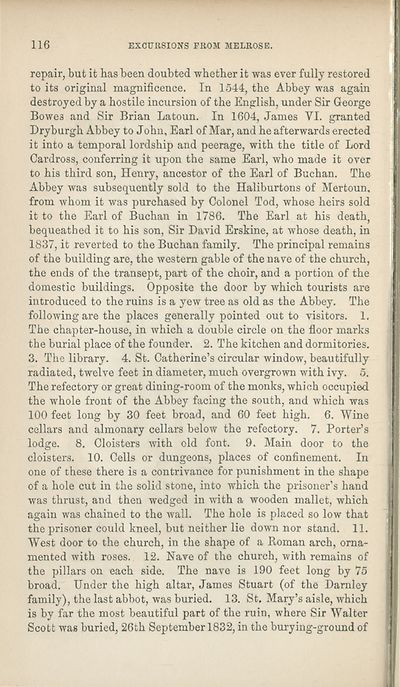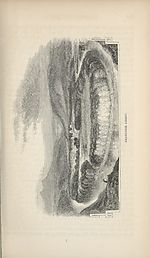Download files
Complete book:
Individual page:
Thumbnail gallery: Grid view | List view

116
EXCURSIONS FROM MELROSE.
repair, but it has been doubted whether it was ever fully restored
to its original magnificence. In 1544, the Abbey was again
destroyed by a hostile incursion of the English, under Sir George
Bowes and Sir Brian Latoun. In 1604, James YI. granted
Dryburgh Abbey to John, Earl of Mar, and he afterwards erected
it into a temporal lordship and peerage, with the title of Lord
Cardross, conferring it upon the same Earl, who made it over
to his third son, Henry, ancestor of the Earl of Buchan. The
Abbey was subsequently sold to the Haliburtons of Mertoun,
from whom it was purchased by Colonel Tod, whose heirs sold
it to the Earl of Buchan in 1786. The Earl at his death,
bequeathed it to his son, Sir David Erskine, at whose death, in
1837, it reverted to the Buchan family. The principal remains
of the building are, the western gable of the nave of the church,
the ends of the transept, part of the choir, and a portion of the
domestic buildings. Opposite the door by which tourists are
introduced to the ruins is a yew tree as old as the Abbey. The
following are the places generally pointed out to visitors. 1.
The chapter-house, in which a double circle on the floor marks
the burial place of the founder. 2. The kitchen and dormitories.
3. The library. 4. St. Catherine’s circular window, beautifully
radiated, twelve feet in diameter, much overgrown with ivy. 5.
The refectory or great dining-room of the monks, which occupied
the whole front of the Abbey facing the south, and which was
100 feet long by 30 feet broad, and 60 feet high. 6. Wine
cellars and almonary cellars below the refectory. 7. Porter’s
lodge. 8. Cloisters with old font. 9. Main door to the
cloisters. 10. Cells or dungeons, places of confinement. In
one of these there is a contrivance for punishment in the shape
of a hole cut in the solid stone, into which the prisoner’s hand
was thrust, and then wedged in with a wooden mallet, which
again was chained to the wall. The hole is placed so low that
the prisoner could kneel, but neither lie down nor stand. 11.
West door to the church, in the shape of a Roman arch, orna¬
mented with roses. 12. Nave of the church, with remains of
the pillars on each side. The nave is 190 feet long by 75
broad. Under the high altar, James Stuart (of the Damley
family), the last abbot, was buried. 13. St, Mary’s aisle, which
is by far the most beautiful part of the ruin, where Sir Walter
Scott was buried, 26th September 1832, in the burying-ground of
EXCURSIONS FROM MELROSE.
repair, but it has been doubted whether it was ever fully restored
to its original magnificence. In 1544, the Abbey was again
destroyed by a hostile incursion of the English, under Sir George
Bowes and Sir Brian Latoun. In 1604, James YI. granted
Dryburgh Abbey to John, Earl of Mar, and he afterwards erected
it into a temporal lordship and peerage, with the title of Lord
Cardross, conferring it upon the same Earl, who made it over
to his third son, Henry, ancestor of the Earl of Buchan. The
Abbey was subsequently sold to the Haliburtons of Mertoun,
from whom it was purchased by Colonel Tod, whose heirs sold
it to the Earl of Buchan in 1786. The Earl at his death,
bequeathed it to his son, Sir David Erskine, at whose death, in
1837, it reverted to the Buchan family. The principal remains
of the building are, the western gable of the nave of the church,
the ends of the transept, part of the choir, and a portion of the
domestic buildings. Opposite the door by which tourists are
introduced to the ruins is a yew tree as old as the Abbey. The
following are the places generally pointed out to visitors. 1.
The chapter-house, in which a double circle on the floor marks
the burial place of the founder. 2. The kitchen and dormitories.
3. The library. 4. St. Catherine’s circular window, beautifully
radiated, twelve feet in diameter, much overgrown with ivy. 5.
The refectory or great dining-room of the monks, which occupied
the whole front of the Abbey facing the south, and which was
100 feet long by 30 feet broad, and 60 feet high. 6. Wine
cellars and almonary cellars below the refectory. 7. Porter’s
lodge. 8. Cloisters with old font. 9. Main door to the
cloisters. 10. Cells or dungeons, places of confinement. In
one of these there is a contrivance for punishment in the shape
of a hole cut in the solid stone, into which the prisoner’s hand
was thrust, and then wedged in with a wooden mallet, which
again was chained to the wall. The hole is placed so low that
the prisoner could kneel, but neither lie down nor stand. 11.
West door to the church, in the shape of a Roman arch, orna¬
mented with roses. 12. Nave of the church, with remains of
the pillars on each side. The nave is 190 feet long by 75
broad. Under the high altar, James Stuart (of the Damley
family), the last abbot, was buried. 13. St, Mary’s aisle, which
is by far the most beautiful part of the ruin, where Sir Walter
Scott was buried, 26th September 1832, in the burying-ground of
Set display mode to:
![]() Universal Viewer |
Universal Viewer | ![]() Mirador |
Large image | Transcription
Mirador |
Large image | Transcription
| Antiquarian books of Scotland > Scotland/Scots > Black's picturesque tourist of Scotland > (176) |
|---|
| Permanent URL | https://digital.nls.uk/130030302 |
|---|
| Description | Thousands of printed books from the Antiquarian Books of Scotland collection which dates from 1641 to the 1980s. The collection consists of 14,800 books which were published in Scotland or have a Scottish connection, e.g. through the author, printer or owner. Subjects covered include sport, education, diseases, adventure, occupations, Jacobites, politics and religion. Among the 29 languages represented are English, Gaelic, Italian, French, Russian and Swedish. |
|---|

